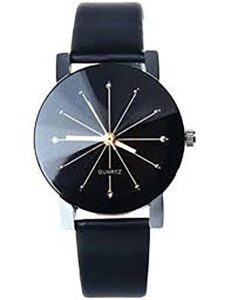What Does Quartz Mean And How Does It Work?
Why does my watch or clock read quartz? A lot of our customers assume that the word “quartz” that’s usually inscribed somewhere on the dial is indicating that the glass covering the face of the time piece is made out of quartz crystal. While quartz crystal is an integral part of battery-powered time pieces, it’s just not quite hard enough to be impact resistant for use on the face. Not a bad guess though!
The glass covering on time pieces is often referred to as the crystal. Mineral glass is the most commonly used as it is inexpensive to manufacture, has a hardness rating of 5 on the Mohs scale (said scale being 1-10, 1 being the softest, 10 being the hardest), compared to the rating of 2 for its lesser quality compadre, the acrylic “crystal”. Sapphire glass has a rating of 9, which puts it one spot below the hardness of a diamond on the same scale. Sapphire is obviously the superior choice, but it comes with a catch: it’s quite a bit more expensive, which is why mineral glass and acrylic tend to be what manufacturers pick when they mass produce time pieces.

Simply put, the word quartz being inscribed on the dial of your timepiece is showing that it’s battery-powered. Mechanical time pieces use gears and the energy of properly wound springs to ensure the hands move at the measure of time. While quartz time pieces use the same gears and other parts used in mechanical watches that ensure the accuracy of time keeping, they also use something that’s become quite popular in recent years: quartz crystal.
Quartz crystal is made up of silicon dioxide (oxygen), which makes this mineral widely available in today’s modern world. Quartz crystal isn’t specific to just the timekeeping world, there is also a significant chance it’s in the very device you’re using to read this blog as it’s commonly used in conjunction with microchips! Quartz is piezoelectric, which is just a fancier way of saying that when force is applied to a specific type of object, said object generates an electric charge of sorts. Simply put: when you push on a quartz crystal you transfer energy into it, and it responds by sending out vibrations. Quartz timepieces use this characteristic to their advantage in the most effective and controlled way.

Here’s a basic break down of how a quartz time piece works: The battery sends a specific voltage of energy into the microchip that is attached to a quartz crystal oscillator. This causes the quartz crystal, (which is shaped the same as a mechanical tuning fork within the oscillator) to vibrate or shake a specific number of times per second. The microchip then counts every single one of those vibrations until the proper number has been met. It will then turn each of those vibrations, all 32,768 of them, into pulses that are regulated at one per second. The microchip is also attached to what is called a stepping motor, which converts those pulses into mechanical energy. The motor turns the gears inside the watch, which then turn the hands of the time piece at the exact measure of time. Pretty cool, right?
Even cooler is that such little energy is needed for the battery to vibrate the quartz crystal that it can last up to 3 years, sometimes more if you’re lucky. Have you ever had a quartz watch that started losing time, but didn’t actually stop or maybe it would stop and then start, but couldn’t figure out why? Perhaps you’ve also encountered a watch that, even with a fresh and fully charged battery, it still won’t keep accurate time? That’s probably because the battery, having lost most of its stored energy but not all of it, sent smaller voltage to the microchip, which causes the quartz crystal oscillator to oscillate at a slower speed, which makes the motor spin the gears slower than needed to keep the hands reading time accurately.
There you have it! The basics of why your time piece reads quartz and how it works! The last thing we feel obligated to touch base on is that we’re sure there are a few people out there who we will have inspired to go digging into their old, probably broken battery-powered time pieces to retrieve that coveted quartz crystal. Be aware though that most manufacturers use synthetic, or man-made quartz crystal to keep costs down for both themselves and for their consumers, as authentic quartz crystal is much more expensive to mine and process.
If you liked this blog, have another question or a suggestion for another blog you’d like us to address, let us know by posting on our Facebook page https://www.facebook.com/TimesTickingwatchrepair Thanks for reading!
Times Ticking has been in operation for more than 30 years, since 1982. We have performed watch repair for customers both locally and internationally. If it Ticks! We KNOW it! Our team of watch repair technicians have a combined experience in watchmaking of over 120 years.

